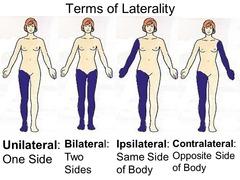Visual inspection with the naked eye of the liver and gallbladder during surgrery is associated with which subdiscipline of anatomy?
gross anatomy
Which of the following is most inferior?
Mediastinum
Pleural cavity
Diaphragm
Pelvic cavity
Cranial cavity
Pelvic cavity
The level of organization when different primary tissues are combined together and work together to perform a common function is called the _______ level.
chemical
cellular
tissue
organ
organismal
organ
What kind of cut would you make in a specimen to create anterior and posterior parts?
coronal
Describe anatomical position
facing forward, head level, thumbs out, feet together and forward
A patient or cadaver lying flat on his/her back is said to be in the __________ position.
supine
what is histology?
subdiscipline of anatomy; the study of the microscopic structure of tissues
What are the subdivisions of gross anatomy?
surface anatomy, regional anatomy, and systemic anatomy
surface = anatomical structures visible on the surface of the body
regional = bones muscles nerves vessels of an entire region
systemic = all muscles of the entire body or all bones of entire body
put in order levels of structural organization from smallest to biggest
chemical (atoms --> molecules --> organelles)
cellular
tissue
organ
organ system (we have 11)
organismal
what are the different tissue types of the human body?
epithelial, muscle, connective, and nervous
define anterior and posterior and name another word for each
anterior is toward the front of the body (ventral) and dorsal is toward the back of the body (posterior)
define superior vs inferior and name another word for each
superior (cranial) is toward the head, inferior is toward the bottom of the body (caudal)
define medial vs lateral
medial is toward the midline of the body and lateral is further from the midline
define superficial vs deep
superficial is toward the surface of the body and deep is toward the center
define proximal vs distal
proximal is closer to the attachment of the limb, distal is further away
Be able to label unilateral, ipsilateral, bilateral, and contralateral

how do transverse, coronal (frontal) and midsagittal planes divide the human body?
transverse plane cuts through waist so body is divided in top and bottom
coronal cuts so there is an anterior and posterior half
midsagittal cuts body into two symmetric halves
which body cavity contains brain and spinal cord?
dorsal
in which body cavity is the heart housed?
inferior mediastinum
in which body cavity are the trachea and esophagus housed?
superior mediastinum
the ventral body cavity includes which two other body cavities?
the thoracic and abdominopelvic body cavities
what does the pleural cavity house?
the lungs
what are the eleven systems of the body?
skeletal
muscular
cardiovascular
lymphatic
nervous
endocrine
respiratory
digestive
urinary
reproductive
integumentary
what are the major components and functions of the skeletal system?
bones, cartilage, tendons, ligaments, and joints
support, protection, leverage, hematopoiesis, mineral storage, and energy storage
what are the major components and functions of the muscular system?
skeletal, cardiac, and smooth muscle
heat production, movement
what are the major components and functions of the cardiovascular system?
heart, blood vessels, blood
transportation of oxygen and nutrients, removal of waste and carbon dioxide, and hormone transportation
what are the major components and functions of the lymphatic system?
lymph vessels, lymph nodes, thymus gland, tonsils, and spleen
fluid control, filtration, immunity
what are the major components and functions of the nervous system?
brain, spinal cord, nerves, sense organs
communication and homeostasis
what are the major components and functions of the endocrine system?
hormone producing glands and cells
communication and homeostasis
what are the major components and functions of the respiratory system?
nasal cavity, pharynx, larynx, trachea, bronchi, lungs
gas exchange
what are the major components and functions of the digestive system?
alimentary canal, salivary glands, liver, gallbladder, pancreas
mechanical and chemical breakdown of food, absorption, solid waste removal
what are teh major components and functions of the urinary system?
kidneys, ureters, urinary bladder, urethra
filtration and elimination
what are the major components and functions of the reproductive system?
male: testes, duct system glands
female: ovaries, uterine tubes, uterus, vagina, and external genitalia
production of hormones, production of germ cells, housing developing fetus
what are the major components and functions of the integumentary system?
skin, sebaceous (oil) glands, sudoriferous glands (sweat), hair, nails
protection, temperature regulation, waste elimination, sensation